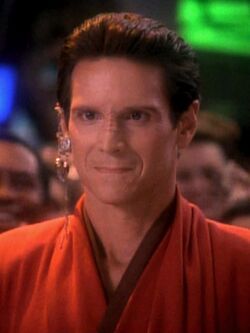Bajoran: Difference between revisions
No edit summary |
Nicesociety (talk | contribs) |
||
| (18 intermediate revisions by 5 users not shown) | |||
| Line 1: | Line 1: | ||
The | The [[Bajoran]]s are a humanoid species native to the planet [[Bajor]] in the [[Alpha Quadrant]]. The Bajorans have one of the oldest and richest cultures in the quadrant, though in recent history they have suffered greatly at the hands of the [[Cardassian Union]]. With their liberation from the Cardassians and the discovery of the [[Bajoran Wormhole]], the Bajorans are taking a new place as major players on the interstellar stage. | ||
==Physiology== | ==Physiology== | ||
Bajorans resemble [[Human]]s in appearance, and are distinguished by a series of four to seven creases across their noses. The Bajoran heart is mirrored along a horizontal axis, unlike the human heart, which is mirrored along a vertical axis. A puncture in the lower ventricle of the heart will cause instantaneous death. Bajoran women gestate for only five months, forming an intricate network of blood vessels between the mother and the fetus. During the pregnancy, Bajoran women are frequently afflicted by bouts of uncontrollable sneezing | [[file:Bajoran Female.jpg|thumb|250px|right|A Bajoran Female]] | ||
Bajorans resemble [[Human]]s in appearance, and are distinguished by a series of four to seven creases across their noses. The Bajoran heart is mirrored along a horizontal axis, unlike the human heart, which is mirrored along a vertical axis. A puncture in the lower ventricle of the heart will cause instantaneous death. Bajoran women gestate for only five months, forming an intricate network of blood vessels between the mother and the fetus. During the pregnancy, Bajoran women are frequently afflicted by bouts of uncontrollable sneezing. | |||
==Government== | ==Government== | ||
Following the Cardassian withdrawal from Bajor, the interim [[Bajoran Provisional Government]] was set up to administer the planet and its various colonies. Bajoran politics is balanced between the secular [[Chamber of Ministers]], led by the | Following the Cardassian withdrawal from Bajor, the interim [[Bajoran Provisional Government]] was set up to administer the planet and its various colonies. Bajoran politics is balanced between the secular [[Chamber of Ministers]], led by the First Minister, and the religious [[Vedek Assembly]], led by the [[Kai]]. It is possible for one individual to be both the Kai and the first minister simultaneously, as Winn Adami almost was in 2371. In 2374, the Bajorans applied for membership in the [[Federation]], and were admitted in 2380. However, they have since seceded since the start of the [[Federation Civil War]]. | ||
==Religion and Spirituality== | ==Religion and Spirituality== | ||
[[File:Bajoran Male.jpg|thumb|250px|right|A Bajoran Male]] | |||
The [[Bajoran | The [[Bajoran Religion]] is a major unifying force on the planet; the spiritual leader, or [[Kai]], wields a great deal of moral and political authority, advising and influencing the planet's political leader, the First Minister. The Kai is chosen from a council of [[Vedek]]s, the title given to Bajoran religious leaders. Other religious titles are [[Ranjen]]s and [[Prylar]]s. The Bajoran religion is based upon the revelations of the [[Prophets]], who come to be known as the timeless beings residing in the [[Bajoran Wormhole]], or as it is called by the Bajorans, the [[Bajoran Wormhole|Celestial Temple]]. Since [[Starfleet]] officer Benjamin Sisko was the first to make contact with them, he is acclaimed by the Bajoran spiritual leadership as the [[Emissary]] of the Prophets. Part of the Bajoran religion involves the use of the [[Tears of the Prophets]], reality-distorting energy orbs produced by the Prophets. Several of these were stolen by the Cardassians during the Occupation, though most have been recovered. | ||
==Language== | ==Language== | ||
| Line 34: | Line 21: | ||
===Names=== | ===Names=== | ||
Bajoran custom places the surname (or family name) before the given name (Similar to the | Bajoran custom places the surname (or family name) before the given name (Similar to the Chinese naming customs of [[Earth]]). Therefore, [[Rank|Captain]] [[Remae Ktell]] would properly be addressed as Captain Remae, not Captain Ktell. | ||
[[Category:Database]][[Category: Species]] | |||
Latest revision as of 20:41, 9 April 2010
The Bajorans are a humanoid species native to the planet Bajor in the Alpha Quadrant. The Bajorans have one of the oldest and richest cultures in the quadrant, though in recent history they have suffered greatly at the hands of the Cardassian Union. With their liberation from the Cardassians and the discovery of the Bajoran Wormhole, the Bajorans are taking a new place as major players on the interstellar stage.
Physiology[edit]
Bajorans resemble Humans in appearance, and are distinguished by a series of four to seven creases across their noses. The Bajoran heart is mirrored along a horizontal axis, unlike the human heart, which is mirrored along a vertical axis. A puncture in the lower ventricle of the heart will cause instantaneous death. Bajoran women gestate for only five months, forming an intricate network of blood vessels between the mother and the fetus. During the pregnancy, Bajoran women are frequently afflicted by bouts of uncontrollable sneezing.
Government[edit]
Following the Cardassian withdrawal from Bajor, the interim Bajoran Provisional Government was set up to administer the planet and its various colonies. Bajoran politics is balanced between the secular Chamber of Ministers, led by the First Minister, and the religious Vedek Assembly, led by the Kai. It is possible for one individual to be both the Kai and the first minister simultaneously, as Winn Adami almost was in 2371. In 2374, the Bajorans applied for membership in the Federation, and were admitted in 2380. However, they have since seceded since the start of the Federation Civil War.
Religion and Spirituality[edit]
The Bajoran Religion is a major unifying force on the planet; the spiritual leader, or Kai, wields a great deal of moral and political authority, advising and influencing the planet's political leader, the First Minister. The Kai is chosen from a council of Vedeks, the title given to Bajoran religious leaders. Other religious titles are Ranjens and Prylars. The Bajoran religion is based upon the revelations of the Prophets, who come to be known as the timeless beings residing in the Bajoran Wormhole, or as it is called by the Bajorans, the Celestial Temple. Since Starfleet officer Benjamin Sisko was the first to make contact with them, he is acclaimed by the Bajoran spiritual leadership as the Emissary of the Prophets. Part of the Bajoran religion involves the use of the Tears of the Prophets, reality-distorting energy orbs produced by the Prophets. Several of these were stolen by the Cardassians during the Occupation, though most have been recovered.
Language[edit]
Spoken Bajoran has many dialects and is used as the official language of Bajor and its colonies.
The Bajoran written language consists of square symbols which are composed of thick lines. There are a large number of different symbols which can be used in any of four rotations (normal, horizontally flipped, vertically flipped, 180 degree rotation). This gives anywhere between 50 to 200 symbols in the written language. The number of characters in the script implies that its either syllabic or logosyllabic. Modern Bajoran text usually requires pairs of symbols to write words and concepts, although odd numbers of characters are also used in bajoran texts (possibly as abbreviations). Both ancient and modern Bajoran text has been called ideographic - each character or a pair of characters represents a single thought pictured, however as with Chinese (most chinese characters represent syllables and have a semantic component, they are very few true ideograms), this is probably a misconception. Given the possible number of symbols, Bajoran writing is likely syllabic or logosyllabic.
Culture and Society[edit]
Bajoran culture and customs are closely tied with Bajor's religious beliefs.
Names[edit]
Bajoran custom places the surname (or family name) before the given name (Similar to the Chinese naming customs of Earth). Therefore, Captain Remae Ktell would properly be addressed as Captain Remae, not Captain Ktell.

